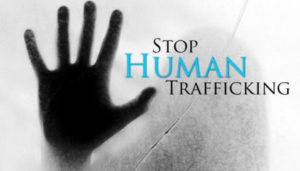 Did you know that in 2014, there were 117,000 ads posted on the escort section of www.backpage.com in North Dakota soliciting sex? Think about that. Think about how much demand for sex there is in our state- 117,000 posts in one year. Not to mention, that is just one of the many websites where sex is being sold each and every day.
Did you know that in 2014, there were 117,000 ads posted on the escort section of www.backpage.com in North Dakota soliciting sex? Think about that. Think about how much demand for sex there is in our state- 117,000 posts in one year. Not to mention, that is just one of the many websites where sex is being sold each and every day.
ND is a popular place for trafficking. Most people think that trafficking is an issue in Western ND specific to the oil boom. Yes, the oil boom brought more trafficking, and continues to have large numbers of trafficking. The oil boom also shed light onto this as an issue in ND, but Eastern ND currently has higher numbers of trafficking than the West. Fargo, specifically, is the hub of trafficking in ND. Why Fargo, you ask? Fargo has 2 intersecting interstates for easy travel, it is close to Minneapolis, and high gang/drug activity. Fargo has numerous concerts, events, games, etc.. every single day.
THE DEFINITION
The Process (What is done)
Recruiting, harboring, moving, obtaining, or maintaining a person
The Means (How it is done)
Threat or use of force, coercion, abduction, fraud, deception, abuse of power or vulnerability, or giving payments or benefits to a person in control of the victim
The End (Why it is done)
Involuntary servitude, debt bondage, slavery, sex trade, or the removal of organs.
Clear as mud? Let me break it down for you…. If two people are involved in a situation where one person is being used for the other person’s advantage, that would be considered exploitation. Trafficking is similar, but with trafficking there would be a third party benefit. This happens in a variety of different ways in ND. For example, let’s say I am in high school and my boyfriend tells me to sleep with his best friend. He tells me it will only be a one time thing because we do not have money for alcohol this weekend, but if I sleep with his best friend his best friend would supply us the alcohol.
Or, let’s say my mom does not have money to pay for rent this month but she tells the landlord he can sleep with me and we won’t have to pay. Both of these examples are considered trafficking:
There is a victim: the girlfriend and the daughter.
There is a trafficker: the boyfriend and the mother
And there is a consumer: the best friend and the landlord
QUIZ TIME
It is up to you to decide if each of these statements are a myth or a fact.
- Human Trafficking means that the victims have to be moving to be considered trafficked.
MYTH
Human trafficking can happen anywhere, anytime. It does not mean that someone needs to be moving around on a circuit. Trafficking can occur in one place over and over, like a house or hotel, and still be considered trafficking. In North Dakota, we see victims from all over the US and some international victims, however more than half of the victims we are serving as service providers are residents on ND, and are sometimes trafficked out of one place and never move around.
Popular places for trafficking are massage parlors and restaurants. - “Prostitution” is a choice.
MYTH
Let me ask you something… In your most loving and healthy relationship do you want to have sex with the person you love 6 times a day, 7 days a week? Of course not! That being said, why would someone want to have sex with 6 strangers a day, 7 days a week? Not knowing who will walk through that door and what freaky fetish they think they can play out on you as an object. And add some violence in there as well….Now, who would honestly choose that? Roughly 5% of people actually choose to utilize ‘sex work’ as their career.
There are reasons why people get trapped into being labor trafficked or get trapped into being a prostituted person. Often times, people do not realize they have a choice. As an example, familial pimping is a thing in ND. Familial pimping means a family member is selling someone in their family, whether to make profit from creating porn, get their rent paid, or their drug habit taken care of. If you were born into a family where this was expected of you, this is normal to you. If your parents, the people you trust, tell you do this and it is ‘normal’, that is what you do. - Children cannot be prosecuted for prostitution.
FACT (in ND)
In August of 2015, North Dakota finally passed Safe Harbor Law. This protects those that are under the age of 18 of being charged as a delinquent due to ‘prostitution’. Instead, they are considered deprived children and are offered victim supportive services. Yay! This is a huge win for ND, but not all states have adopted this law. How contradicting, though, that before this law passed, a child who cannot consent to sex legally could be charged with prostitution.
ND also hired roughly 10 positions specific to combating human trafficking in our state.
Although we have come a long way in ND, just because people turn 18 does not miraculously mean they can now start making good choices and change their life. ND still has a ways to go in combating this issue, but we are on the right track. - Prostituted persons take advantage of unsuspecting men.
MYTH
So, a sex buyer goes online to find someone they want to purchase for sex. They scroll through all the ads/photos. They find one they like, they contact that person and set up a time to meet them. Then, they go to the meeting place and play out their sexual acts with that person and pay them. Now…Let me ask you, at what point was that sex buyer lured into purchasing a human being as a product to do what they want with? - Taken and Pretty Woman are accurate movies displaying what happens in trafficking.
MYTH
Although we see international trafficking where kidnapping takes place, this is not the case. This is not all that trafficking is. Most trafficking in ND takes place by a boyfriend ‘grooming’ a victim or forcing them against their will into prostitution, or it is familial pimping as I described earlier.
Also, Pretty Woman is not what ‘prostitution’ looks like. Richard Gear is not knocking on your door with flowers and drawing you a bath. That just does not happen. - Trafficking is a new issue for ND.
MYTH
Trafficking has been around since the beginning of time. Yes, the oil boom shed light onto this horrific issue in our state, but it did not start it. People think that ‘ND nice’ attitude comes full circle in this state, but not when it comes to trafficking and its prevalence. There is a reason we refer to human trafficking as modern day slavery, because it is similar to and just as much of an issue as slavery was. - Human trafficking is what you see in the media: blonde haired, blue eyed girls shivering in a corner with handcuffs on.
MYTH
You will not always recognize trafficking, and often times we have all come into contact with or worked with someone that was involved in or exposed to sex or labor trafficking. Often times, my coworkers and I chuckle when we Google ‘human trafficking’ or see posters up in the community. We chuckle because when we see these ads, they give a false idea of what trafficking is. Victims we work with may attend school every day, they may have a full time job, they may have children, etc.. and we would never know they were involved in such a horrific experience because they can appear to be ‘normal’. On the flip side, pimps or sex buyers could be your neighbor, your teacher, your pastor….There is no specific way to detect those that may be involved. - Traffickers may brand their victims with tattoos like farmers brand their cattle.
FACT
Traffickers want all control over the lives of their victims. Sometimes traffickers even have their victims get tattoos as a sign of ownership over them. It is a physical and mental manipulation tactic they utilize. A while back, the bar code tattoo was really popular in trafficking, and a bar code number could even be searched online to decipher which pimp that victim belonged to. It is all about control and manipulation in trafficking, and this is a popular way that traffickers ‘prove’ their ownership. - All traffickers/pimps are male.
MYTH
Although we typically see male pimps, female victims, and male buyers, this is not always the case. We too see male victims of trafficking (sex or labor), female pimps or ‘madams’, and female buyers. This scenario is just less common in ND, but it does happen. - Victims want to be referred to as victims.
MYTH
The term ‘victim’ can sound very degrading or powerless to people. I utilize the word ‘victim’ in my trainings/education because it is a universal term that people understand. However, I would never assume that someone is a victim of trafficking or would refer to themselves as such. ‘Victim’ could sound to someone as if they are weak and have been taken advantage of. People need time to understand what has happened to them, and that they have been taken advantage of. Once people heal and come to terms with this, they may be okay referring to themselves as a victim, as a survivor, or as an over-comer, but sometimes they do not want to at all associate with this, and that is okay. - Porn and stripping are gateways into getting involved in sex trafficking.
FACT
Porn and stripping have huge ties to the world of trafficking. Typically this could be how someone becomes exposed to trafficking or is groomed or forced into it. Sometimes porn is made with victims without their knowledge, and used as blackmail against them. When victims get involved into trafficking at a young age (average age in US right now is 15), some traffickers force them to watch porn and manipulate them into thinking that the violent and degrading sex they expose them to is normal and healthy.
Unfortunately, many of the victims we work with in ND have this as a common denominator.
On the flip side, porn and stripping can be associated with how buyers get obsessed with ‘prostitution’. Buyers see and become addicted to the stripping and porn worlds thinking that this behavior is normal. But, when they aren’t receiving that from their significant other, they assume that they can play out their fetishes on someone else and treat them as a product. - Social media is a large risk factor for trafficking. Everyone uses social media therefore everyone could be at risk.
FACT
Social media probably plays into 90% of what we are seeing in ND. Please make sure your children’s GPS is turned off, not only on their settings but also in their phone apps. Traffickers can find their victims through social media very easily, and they do. For example, a 15 year old girl is at the mall with her friends and posts a selfie on Twitter that says ‘looking to have some fun tonight, hit me up!’. A trafficker can go to the mall, pull up an app on his phone that finds all the social media posts from the mall, and sees that girl’s selfie post. He can then click on it and it will pull up a map taking him directly to her location when she posted that selfie. Scary, huh?
Ever heard of Catfishing? People can easily pretend to be someone they’re not over social media, and trick others into thinking they have a loving relationship with them. This is a huge gateway into being trafficked, and it can be violent.
Survival sex in our state is also a big issue, and social media plays into that as well. If mom kicks out her 17 year old daughter and it’s -30 degrees out, what is she to do? If you’re up against survival, you’ll do next to anything to have a warm place to stay, some clothes, and a little food. A 17 year old can post on any social media site that she needs a place to stay, and I can promise you that some sketchy people will reach out to her offering her something she cannot refuse. - All ‘prostitutes’ are drug/alcohol addicts.
MYTH
Although very common, this is not always the case. Sometimes, traffickers force victims to start using drugs even as forcefully as putting a needle in their arm. Once their addiction is formed, victims feel a need to stick with their trafficker to get their drug fix as it is a form of survival for them. If you were being beaten/raped daily, you too may use drugs/alcohol to cope with this horrific lifestyle. Other times, victims have drug/alcohol addictions prior to their involvement into the life. Their trafficker promises an ongoing supply of drugs/alcohol if you ‘just do this simple thing for me’, and then they get sucked in. - There is little money that goes into human trafficking each year.
MYTH
Worldwide, roughly $150 billion is the growing amount that this industry takes in per year. Un-taxed, undocumented money. - Stockholm Syndrome is displayed with trafficking.
FACT
Google ‘Stockholm Syndrome’ if you are unfamiliar with this concept. This is what happens with trafficking therefore trauma bonds are formed. When people ask me, ‘why don’t they just leave?’, it is important to know that they can’t. It is not an option to just leave. Partly because Stockholm Syndrome/trauma bonds have been formed with their trafficker. If their trafficker has been providing their basic needs for them and no one else does, it is hard to leave that situation. If their trafficker has their children, it is hard to leave. If their trafficker threatens their life or the lives of those they love, it is hard to leave. - PTSD (Post Traumatic Stress Disorder) with trafficking victims is just as significant as someone on the front lines of battle.
FACT
There is is so much trauma involved in trafficking that these victims are really tough to work with. They need so many services and tons of support. When there is a significant amount of trauma built up, there is a lot that these victims need to heal from, and it is a long battle. - Victims of human trafficking have an average lifespan of 7 years once they enter.
FACT
If I get involved into trafficking when I am 12 years old, chances of me living until I am 19 are pretty slim. This is due to drug/alcohol overdoses, suicide, violence from the pimps/buyers, or infections/diseases.Pretty terrifying information, huh? It is hard to wrap our heads around this unknown and unfamiliar world of trafficking, but it is out there and our awareness is vital to combating this issue.
We can’t solve problems by using the same kind of thinking we used when we created them ~
-keep shining
(Like and share my Facebook page for ongoing updates and blog posts! www.facebook.com/secretsofsw/)Click here for human trafficking specific Youtube videos:
MTV , America’s Daughters, Chosen, Native American



Recent Comments